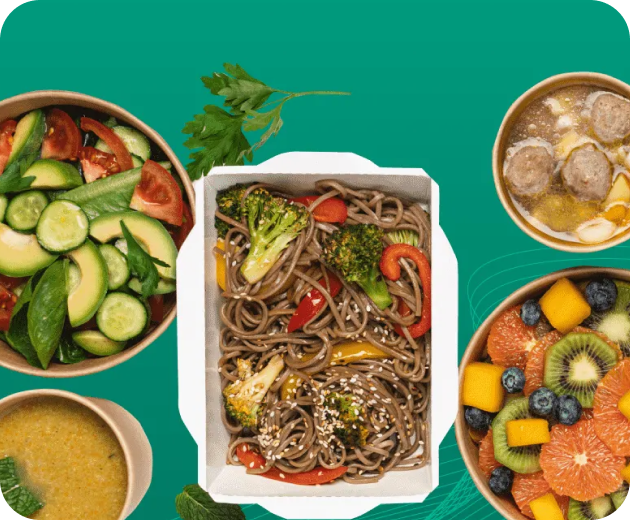Emerging Trends in Food Science: How Tech Innovations Are Reshaping What We Eat
In our tech-centric culture, it’s no wonder the food and beverage market is undergoing a technological renaissance of sorts. Here’s how recent innovations are fueling a food market that centers efficiency, sustainability and variety in 2025.
Want the complete picture of what is coming in 2026? Get the full food trends forecast guide and explore the data, insights, and opportunities driving the industry forward.
What is food science?

As the name would suggest, food science is a branch of science that specifically studies the composition, nutritional implications and development of different types of food. Food science combines elements of chemistry, biology and even physics to help humans better understand where different foods come from and how they can give us the fuel we need to live healthy and full lives.
Branching out from mad science experiments, however, modern food science initiatives have also begun to center artificial intelligence and data-analytics to provide food producers and professional gastronomists with the insights they need to drive responsive food innovations. As data science continues to evolve, so do the possible applications for artificial intelligence and other research-driven innovations in the food and beverage space.
What are the trends in food science?
While new and exciting flavors and products definitely turn heads in restaurants and supermarkets, some of the most exciting food science trends are actually happening behind the scenes. Many of this year’s major food science trends have revolved around production, distribution and sustainability.
For example, some of the major trends we’ve seen in food science this year include:
- Artificial intelligence and predictive analytics in research and development
- Climate-conscious farming practices and sustainable sourcing adaptations
- Development of plant-based protein alternatives
- Growing emphasis on functional nutrition and innovation in fermentation processes
- Interactive food products that allow consumers to customize their preferred flavor profiles
- Automation and robotics for more self-sufficient production processes
- Enhanced packaging for improved freshness and shelf-life optimization
- Continued research and advancement into gut health and probiotics
- Multi-sensory dining experiences
These trends represent just the tip of the iceberg in terms of food science innovations, but all of them highlight the unique ways in which technology and natural elements can combine to produce more engaging and satisfying products and experiences.
How technology is transforming food science
Historically, cooking and eating have been simple, manual processes that did not rely on advanced machinery or complicated technology. Today, however, technology has become increasingly vital to the food and beverage industry. Advanced tech solutions can be found in factory assembly lines and home kitchens alike, making it absolutely crucial for professionals in the food and beverage space to embrace and invest in new and emerging food tech.
In addition to supporting production at macro and micro levels, technology solutions are at the heart of all modern food research efforts. Just like the internet revolutionized the research and development process at the beginning of the millennium, artificial intelligence has further crystallized the vital role technology and data play in the creation and distribution of successful food and beverage products.
An AI platform for food innovation like Tastewise enables companies to test concepts virtually, isolate products that are more aligned with consumer needs and even forecast which attributes and delivery formats are most likely to resonate with audiences in the future. By investing in tech-driven market research at the top of the funnel, brands can stay laser-focused on efforts that are more likely to deliver results rather than wasting their time on multiple swings and misses.
Sustainability and climate-smart food solutions
Recent research indicates that 73% of Gen Z consumers are willing to spend more money on products from sustainable brands. For this reason, many companies have turned to science to help them reduce their carbon footprints and prioritize sustainability in their production and distribution efforts.
As climate change continues to intensify, demand for eco-friendly products will continue to grow among consumers from all generations. Today’s food scientists are being asked to meet this growing demand by developing sustainable solutions for common consumer pain points. Upcycled ingredients, precision fermentation, sustainable farming practices and regenerative agriculture all employ advancements in food science while aligning with the needs of eco-conscious consumers.
Advances in food safety and quality control
Consumers don’t just want their food to taste good – they want it to be safe and consistent with respect to quality. What once was a guessing game, however, has become a more exact science thanks to recent technological innovations. For example, advanced biosensors can help detect potential environmental or product contaminants to reduce the potential for food-borne illnesses.
Similarly, AI for CPG brands may be able to streamline the quality control process by automating quality checks and analyzing data in real time. All of these enhancements serve to improve upon potential tedious workflows and deliver more satisfactory goods without seriously impacting companies’ bottom lines.
Alternative ingredients and proteins
Today’s consumers are perhaps more health-conscious than ever before. With an ever-growing number of foodies embracing vegan, vegetarian, low-carb and gluten-free lifestyles, food scientists have had their work cut out for them in terms of developing compelling and convincing plant-based meat and dairy alternatives.
The development of alternative proteins has been a particularly interesting branch of food science, as developers have continued to push the envelope on what was once thought possible in this space. Ongoing experiments and research studies have sought to rule out subpar meat and dairy substitutes and rule in products that convincingly replicate the taste, texture and nutritional value of popular animal-sourced proteins.
Sensory science and consumer experience trends
Many of us think about culinary experiences as being solely taste-driven. However, today’s dining experiences are meant to appeal to all five senses simultaneously. As a result, many food service brands are embracing sensory-focused experiential dining offers that encourage participants to engage the full spectrum of their sensory capabilities.
Given that roughly 72% of today’s diners are specifically seeking out experiential dining options, many companies are leveraging technology solutions to deliver singular experiences that will be remembered for years to come. Projection mapping, sonic food pairings, tableside creations and “taste the movie” offerings use advanced technology solutions and multimedia content to deliver fun and personalized experiences that resonate with diners from all walks of life.
The future of food research and development
The sky is the limit for potential food AI and technology uses. We have only just begun to scratch the surface of these innovations, and the years ahead are sure to take food trends to levels we previously thought were unattainable. Just as the last two decades have centered around advancements in digital technology and online data analytics, the next several years will likely serve as ground zero for a growing slate of advanced technology solutions that make food more exciting and accessible for all.
Between advancements in production protocols, enhanced sustainability options, and tech-based experiential dining offerings, the next decade is sure to surprise us all with its versatility, flexibility and endless customizability in the food and beverage space. Whether you’re looking to leverage molecular gastronomy to elevate your flavor offerings or harness AI for CPG R&D, there’s no shortage of opportunities to add a splash of science to your daily routines.
FAQs about trends in food science
AI plays a critical role in helping brands predict which ingredients are likely to drive future food trends and in streamlining standard research and development protocols. For example, platforms like Tastewise use food AI to provide food retailers with clear and comprehensive consumer intelligence data that can help them make more informed decisions about their product offerings, investment strategies and marketing angles.
Consumers love novelty, and food science often sparks the innovation necessary to deliver new and engaging products and experiences to all. Just as consumer behaviors influence food science efforts, innovations in the food science space can drive consumer preferences. Whether food science is part of the back-end R&D process or serves as the basis for an experiential dining format, integrating scientific and technological advancements into standard workflows can help brands expand their target audiences.
In 2026, we expect that the biggest food science movers and shakers will include AI-assisted flavor creation, alternative ingredient development, sustainable sourcing solutions and multimedia dining experiences. We also anticipate that artificial intelligence and data analytics will continue to play vital roles in the development, marketing and distribution of popular food and beverage products.




